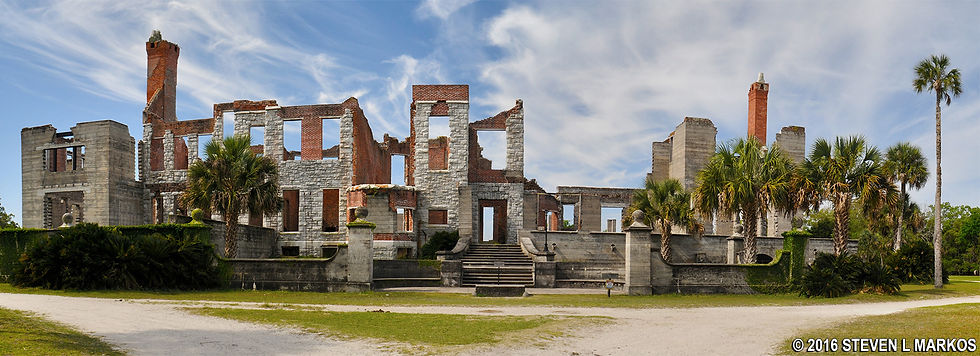The Ideal Island Getaway: Cumberland Island
- Charlotte Warren
- Jul 10, 2021
- 3 min read
Updated: Jul 15, 2021
Few places in this world remain undeveloped, as our ever-growing global population begs persistently for more infrastructure. However, lying just off the coast of Georgia, an island stands in bold defiance against these 21st-century norms; Cumberland Island is one of the largest undeveloped islands in the United States today. Entangled in the gnarled branches of centuries-old oak trees, and hanging amongst the dripping Spanish moss, is a rich and complex history of Native Americans, colonialism, slavery, and a wedding-of-the-century held in secret.

The beautifully undisturbed beach of Cumberland Island
The Native Americans christened the island with its original name, anglicized as "Missoe," when they became the first (known) humans to call the land home. As early as 4,000 years ago, tribes like the Timucua, and later the Tacatacuru, inhabited Missoe, surely taking advantage of its warm climate and fertile environment. Eventually, Spanish colonialism weakened the Tacatacuru, allowing a multi-ethnic tribe known as the Yamasee to take control instead. Remnants of this Native American past can still be found in the soil today, where tourists and archaeologists alike have found arrowheads, pottery shards, and even teeth. These artifacts serve as reminders of an all-but-forgotten story, one that could have played out very differently had the British not arrived...
Spanish control of the island gave way to English colonialism sometime around 1733, when James Oglethorpe (founder of the colony of Georgia) washed ashore on the southeastern coast of the United States. Consequently, the island changed names: "Cumberland" after the Duke of Cumberland, son of King George II. The name-change seemed symbolic of the widespread suppression and genocide of native tribes at the hands of British colonizers. And as if the mistreatment of one ethnic group wasn't enough, the island soon bore witness to plantation culture and slave ownership. In 1884, the Greene family (later called the Miller family) built "Dungeness," where over 200 slaves lived and worked, harvesting valuable crops such as cotton, indigo, and rice. Ruins of Dungeness still haunt the island, ashen and scorched after a fire that consumed the majority of the mansion in 1959.

The eerie remains...

...of a once imposing mansion
Serving as very tangible evidence of Cumberland's slave history is First African Baptist Church. Established in 1893, African slaves and their families, as well as their descendants, used the tiny structure as a worship space, hopefully finding inside its walls a morsel of reprieve from their tortured lives. Today, the site still hosts wedding ceremonies, though few and far between, the most famous of which being the marriage of John F. Kennedy Jr. to Carolyn Bessette. As one could imagine, the massive public image of the Kennedy family raised the need for a quiet nuptials, and what better place to secretly wed than Cumberland Island. So, in September of 1996, John Jr. and Carolyn left the chapel a married couple, applauded by only a small crowd of witnesses.

The simple interior of First African Baptist Church, which only allows space for a handful of people.

A stone plaque residing on the exterior of the building, documenting the founding members of the church

If only walls could talk: an unassuming building full of priceless tales

Congrats to the happy couple! JFK Jr. and Carolyn Bessette leave First African Baptist Church.
Today, the Carnegies, along with several other families, own certain parts of the island, while the rest remains protected by the state and national governments. Despite the partitioned ownership, the goal of all parties involved is the same: keep Cumberland as natural and as wild as possible. The incredible wildlife keeps everyone on their toes, as many visitors giggle with glee upon spotting the wild horses, or the giant sea turtles who hoist themselves ashore during a hot summer's night to lay their eggs. For me, this island means many, many things, as I have regularly visited with family and friends throughout my entire life. The experience is so unlike any other vacation, and I find that I am able to build an almost immediate rapport with anyone who has visited the island. The mutual understanding of the pure magic that is Cumberland Island can connect two strangers faster than you can say "à la plage !"

A herd of wild horses enjoy their evening in an expansive pasture: the perks of living in an undeveloped land. Cumberland Island remains one of the only places left in the world to inhabit wild horses.
Image sources (in order of appearance):
Markos, Steven L. "Panoramic view of Dungeness Mansion." National Park Planner. 2016. Web. https://npplan.com/parks-by-state/georgia/cumberland-island-national-seashore-park-at-a-glance/cumberland-island-national-seashore-historical-sites/cumberland-island-national-seashore-dungeness/cumberland-island-national-seashore-dungeness-mansion/
"The approach to Dungeness Mansion." National Park Service. Cumberland Island National Seashore Archives 4648. Web. https://www.nps.gov/articles/975727.htm#4/34.45/-98.53
Reggie, Dennis. JFK Jr. and Carolyn Bessette leaving First African Baptist Church. The Knot. 1996. Web. https://www.theknotnews.com/john-f-kennedy-jr-carolyn-bessettes-wedding-photographer-exclusive-13387
To learn more, visit: https://www.exploregeorgia.org/article/cumberland-island-from-camping-to-the-carnegies
© 2021 Charlotte Warren. All rights reserved.


Comments